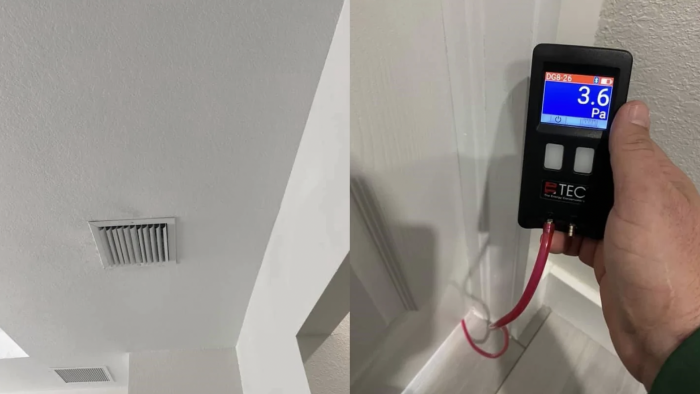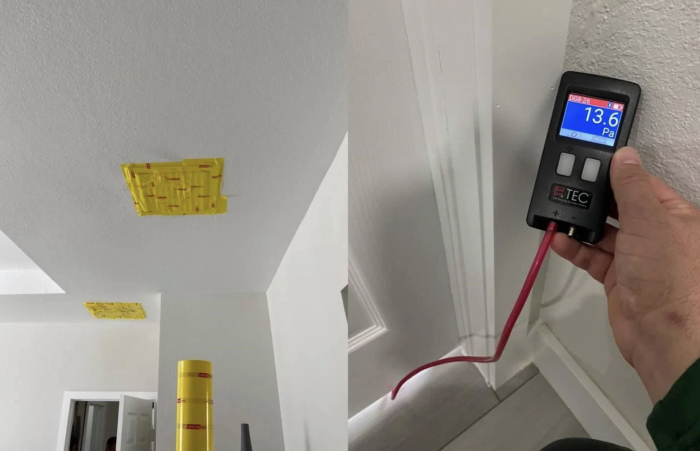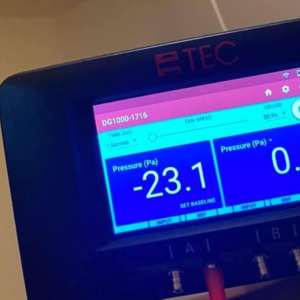
This article was originally published by the HVAC School. It is the first in a three-part series.
Zonal pressure diagnostics (ZPD) have been around for a while. Here is a brief description of ZPD from the website redcalc.com: “Formerly known as the ‘Blasnik methods’ in a nod to their main inventor, zone pressure diagnostics has become an established tool for diagnosing indirect air leakage paths in houses since its introduction to the U.S. weatherization community around 1990. In cases where air must pass through at least two barriers to leak into or out of a house, ZPD are a way to use measured pressures to infer the location and size of air leakage paths.”
There is also this description from The Energy Conservatory taken from the operation manual of an older blower door: “Diagnostic procedures have been developed over the past decade to analyze series leakage. ZPD are widely used by weatherization professionals to prioritize air-sealing efforts in houses by estimating the amount of air leakage from attached zones (e.g., attics, crawlspaces, garages, and basements). ZPD techniques typically combine blower door airtightness test results with zone pressure measurements made both before and after an opening or hole has been added to one surface of the zone being tested.”
How we are misrepresenting ZPD
We are, by and large, misusing ZPD to estimate how leaky a room can be. When we use a blower door, the pressure in the envelope can be driven and maintained at an industry-standard -50 Pascals (Pa). That is a safe pressure differential between indoors and outside that we can use to cancel out the effects of wind and stack effect on a structure.
Once the envelope pressure is maintained at -50 Pa, the practice is to isolate a given room inside the conditioned space, generally by way of a door. At this point, with the “reference or” port left open to factor the house pressure, a tube connected to the “input or +” port on a precision manometer is slid under the door. After that, we can read the pressure of said room with respect to the rest of the house. We know that the pressure in the main body of the space is -50 Pa. If we read a room pressure of 10 Pa, then it is said that this room is 20% connected to outside (10/50=20%). It makes sense, right? Not quite.
It would make sense if the room did not have any ductwork—or any other penetrations, for that matter—connecting it to the rest of the house. That’s only true when the only connection between the room and the rest of the space is the door under which we slid the tubing. We are accounting for the only path through which pressure from the room can travel to the rest of the house en route to the blower door fan.
However, rooms have ducts. Some have supply ducts only; others have both supply and return air paths. Once you isolate the room by closing the door, its pressure differential–induced draft is also traveling into the main body of the envelope through said ducts on its way to the blower door fan.
Nearly identical rooms, drastically different readings
Let’s take, for example, two identical leak-free 10-ft. by 10-ft. by 9-ft. rooms. They’re next to each other, but one is a corner bedroom with two exterior walls. Let’s call that one Room A. Let’s say it has a window on each wall. That’s one more wall and one more window than its adjacent sibling, which is a middle room—Room B. Invariably, this will mean that the corner room has a greater need for cooling capacity. As such, its design air volume is, let’s say, 150 CFM. The room with the same dimensions next to it only needs 80 CFM because it has less heat gain.
That may result in the corner bedroom having a larger diameter duct to feed the conditioned air. If Room A had an 8-in. round duct and Room B a 6-in. round duct, then A would have around 50 sq. in. of duct area instead of the 28 sq. in. for Room B. These rooms will also need returns. If the returns are sized accordingly, Room A will end up with something like 78 sq. in. of return duct area. Room B will only have 50 sq. in. That is a total of 128 sq. in. for Room A and 78 sq. in. for Room B.
If we open a hole of the same diameter from each room to outside and proceed to perform ZPD using the procedure outlined above, we would find Room A showing a lesser pressure than Room B with respect to the rest of the house. We have two rooms of identical volume and equivalent leakage area, so how could that happen?
Hypothetically speaking, if these rooms were completely isolated from each other—with the exception of the door—and the rest of the house, and neither room had any ducts, then both of their pressures with respect to the house would be identical during ZPD. But because Room A has 40% more duct area than Room B connecting it to the main body of the envelope, Room B’s pressure will be higher than the pressure in Room A—even though they both have the same floor area, volume, and equivalent leakage area to outside. In other words, we would mistakenly conclude that B is leakier than A when, in reality, the leakage is exactly the same. The only difference is that A has a larger path for pressure equalization between it and the rest of the house. In short, bigger hole (A), lower pressure (A); smaller hole (B), higher pressure (B).
Let’s consider an example of the point being made. (This example shows one of many homes I’ve tested where I see this trend time and again.) These first two photos are of ZPD readings taken in an isolated room with both a supply and a return vent. With the blower door running, keeping the house at -50 Pa:

I took these pictures a couple of minutes later, after covering the vents with a duct mask:

The pressure reading more than tripled. If we had accepted the first reading at its face value, we would have grossly underplayed the large amount of attic air leakage coming in through the poor drywall finish around the bath exhaust can. Heck, some might’ve even missed it altogether. The original ZPD reading was less than 10%, so it would be hard to fault a tester for shrugging it off.
Can you see where the process is flawed?
“But what if the ducts are inside?”
That’s a very popular question. The answer is: There is no difference.
Think of a room with a properly sized return duct. If the HVAC system is running and the room is isolated by closing the door to it, the air pressure being created in the room by the supply air feed is also being simultaneously relieved by the return air path. That allows the air to travel back to the HVAC fan through a return duct or through a central return. That happens because of the pressure differential between the isolated room and the adjacent space. The pressure differential is being driven by the indoor motor of the HVAC unit. Following so far? Read it again.
Now, substitute the HVAC unit for the blower door as the pressure differential driving force. Close the same door to the same isolated room. Under those conditions, the forces pressurizing the room are the envelope leaks between the room and the adjacent zones (attic/crawlspace/garage) and any direct-to-outside leaks through window/door gaskets, etc. Now the duct(s) in this room act as an air pressure relief path between the room and the adjacent space, the main body of the house, where the blower door fan is. It works just like a return air duct.
For ZPD purposes, it does not matter if the ducts are inside or outside the envelope. There is still a pressure relief path between the isolated room and the house. It will relieve the pressure in the room if the duct runs through a finished basement, a completely sealed soffit, or exposed inside the envelope. It will relieve the pressure the exact same way it would if it were to run through an unconditioned attic.
The only difference would be that if there is any duct leakage, the duct running through a vented attic will add to the total CFM50 of the envelope. If it were to run inside the conditioned space, this duct leakage would not have any effect on the total leakage of the envelope.
In the next part of this series, I will explore methods that take a different approach to ZPD.
_________________________________________________________________________
Genry Garcia is president of Comfort Dynamics, Inc., a full-service heating, ventilation, and air conditioning mechanical and building control contractor based in Miami, Florida.
Weekly Newsletter
Get building science and energy efficiency advice, plus special offers, in your inbox.














4 Comments
Fascinating and enlightening. Would I be barking up the right tree to say that the main practical takeaway here is to tape off duct registers when conducting ZPD?
I think the main practical takeaway is to wait for part 2 that will, I hope, offer more practical advice.
Nathan - I don’t want to spoil the series by answering that just yet.
Like Charlie alluded to - There are 3 parts in total for this series. They’re all closely interconnected and there will be references from the previous parts as in the next ones too.
I will do my best to contain my antici......... PATION.
Log in or create an account to post a comment.
Sign up Log in